PTO Facilities
P.T.O. Positions
Accessories such as compressors and steering servo pumps etc. can be driven from different power take-off locations on the engine. These locations vary depending on engine type, but generally the accessories can be:
a installed on the engine and be belt driven from a power take-off groove on the crankshaft belt pulley. If the accessory is installed a long way from the engine, engine movement must be taken into consideration e.g by using a spring-loaded guide roller. b installed on the timing cover front or rear, gearwheel driven from the camshaft drive.
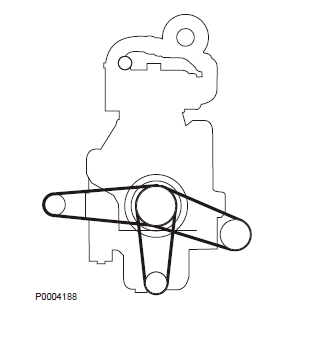
WARNING!
When engines are delivered without protection all rotating parts must be protected if it, after being built into the respective application, is necessary for personal
safety.
Belt Driven P.T.O.
Crankshaft belt pulley, front end
The amount of power available at the crankshaft belt pulley depends on power take-off belt pulley distance from the cylinder block surface and the direction of the vector forces that affect the belt pulley. It is also dependent on belt pulley diameter and engine rpm. Crankshaft belt pulleys are available for every engine type. Some have an integral power take-off groove, while others can be fitted with a bolt-on power take-off disc.
Tightening torques
If the crankshaft belt pulley is changed, the new pulley must be tightened to the correct torque. Tightening torques are stated in the service manual for each engine type.
More detailed information is available in the Sales Support Tool, Partner Network.
Belt Tension
All belt-driven power take-off connections must have the correct belt tension, as insufficient belt tension may cause the belts to slip at high loads and high rpm, which will shorten belt life etc. If the power take-off is driven by the crankshaft, overtight belt tension will cause higher side loads than necessary, which may cause damage to the crankshaft bearing. Belt tension can be tested by applying pressure to the middle on the greatest belt distance between two belt pulleys and adjusting the tension until the belt only yields to a given measurement; refer to the illustration. On installations with several belts where there are two or more belts between two belt pulleys, the belts must have the same length in order for the load to be distributed evenly and for the belts to last as long as possible.
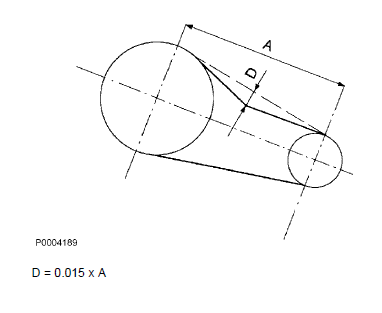
Idler Pulleys
Idler wheels used to tension V-belts must be located on the slack side of the belt and may not be narrower than the minimum diameter recommended by the belt manufacturer.
Belt pulleys that are too small will shorten belt life considerably. A spring-loaded belt pulley is preferable to one that is adjusted and fixed, as a spring-loaded pulley ensures belt tension is maintained. This becomes more important the greater power take-off values are, as tauter belt tension is required to avoid belt slippage, and this causes greater side loads/bending moment on the crankshaft and its bearings.
NOTICE! It is also important to use a spring-loaded idler pulley where internal movement may occur between a flexibly mounted engine and driven equipment installed on a separate chassis.
Gear driven P.T.O.from Timing Case
Limitation
Check that the engine specifications are suitable for the installation of power take-off equipment.
- Weight: Consideration must be given to how much the equipment to be bolted to the timing covers weighs. A support bracket on the cylinder block must be used for heavy equipment.
- Cyclical torque: Certain equipment, e.g. hydraulic pumps, cause large cyclical torque variations on the timing gears. This means that the maximum torque according to the data in the Sales Support Tool, Partner Network, may not be used. All power take-off equipment for connection directly to the timing cover must be approved by Volvo Penta.
PTO (Repto)
The illustration shows where the PTO is located on TAD1370 engines.
The connection point is standard and fits:
1 SAE-B, max load 600 Nm
2 DIN-5462, max load 650 Nm
3 DIN-5462, max load 1000 Nm
NOTICE! DIN-5462 and max load of 1000 Nm may only be ordered when purchasing new engines.
Air Compressors
Air compressors can be driven in the following ways:
1 From the timing gear.
2 By belt drive.
Make sure that the compressor is of a recommended type before it is installed. Otherwise information must be sent to Volvo Penta for approval and to ascertain whether momentary torque loads are within the engine gear wheel transfer capacity and that the compressor is not too heavy.
Things to remember concerning
Power Take-off at the Timing Gears
- The factor that determines drive lifetime is torque.
- If a torque higher than that specified is used, drive lifetime will be shortened.
- If the same power (P) is used at a lower engine rpm, torque will be higher and drive lifetime will therefore be shortened according to the formula:
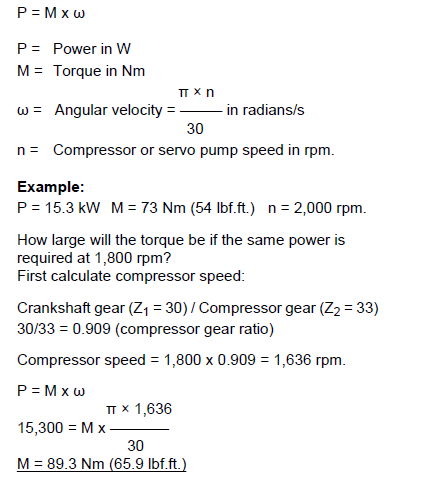
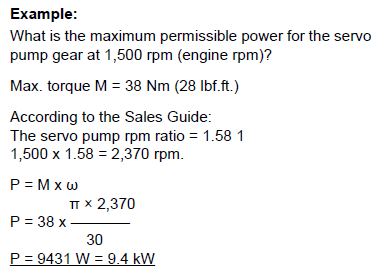
V-Belt Transmissions
V-belt transmissions can easily be adapted to different gear ratios (by using different drive pulley sizes). This type of transmission provides flexible power transfer with a low noise level and requires relatively little maintenance. However, alignment must be accurate and belt tension must be easy to adjust.
Crankshaft Side Loadings, Flywheel End
The permissible crankshaft sideload magnitude depends on the type of engine, operating rpm, and engine application. Original equipment manufacturers may contact Sales
Engineering Industrial, AB Volvo Penta, Sweden for detailed information on maximum permissible crankshaft side loads, and for advice regarding specific installation problems.
Direction of the Side Loadings
The engine will normally manage a greater side load (F) below the shaft than above it, in which case the belt drive must wherever possible be arranged such that the driven equipment is located below the crankshaft centerline. If two or more belt drives are required and it is possible to install them in opposite directions, their effects will cancel each other out and minimize total side load on the crankshaft bearings.
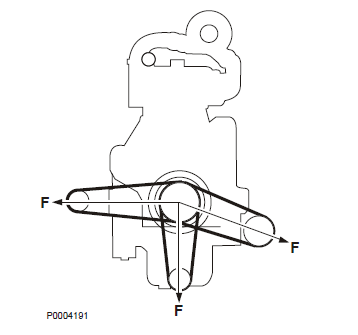
Unsupported P.T.O. Pulley
If it is necessary to use a power take-off belt pulley without support, the design must be inspected and approved by Volvo Penta.
The following information must be provided:
1 Engine specifications:
2 A drawing of the drive arrangements including the following:
a Average diameter of all belt pulleys in the system.
b Power take-off belt distances from the cylinder
block front or rear surface.
c Number, size and type of belts to be used.
d The location of the driven equipment in relation to the engine.
e Belt tensioning method, e.g. adjustable fixed pulley, spring-loaded pulley etc.
f The equipment's maximum and continuous power requirements.
P.T.O. Support Bearings
On installations where it is necessary to transfer large forces or where several belts are required, the power take-off shafts must be supported by bracket bearings or reinforced support bearings. Large side loads occur in V-belt transmissions. We therefore emphasize the importance of accurate alignment. Furthermore, V-belt tension must be checked carefully.
This is especially important if multi-grooved belt pulleys are to be used. If the V-belts are unevenly tensioned in relation to each other, it will lead to increased loads on the bearings and a displacement of the load center. Preferably, use a multi-groove V-belt; see illustration.
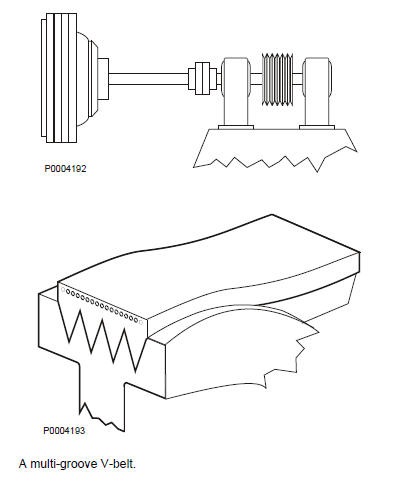
WARNING!
When engines are delivered without protection all rotating parts must be protected if it, after being built into the respective application, is necessary for personal safety.
For More Volvo Engine workshop information, please visit
Rear Engine Mounting of Volvo Engine
Copyright © Guangxi Dingbo Generator Set Manufacturing Co., Ltd. All Rights Reserved | Sitemap
Update cookies preferences